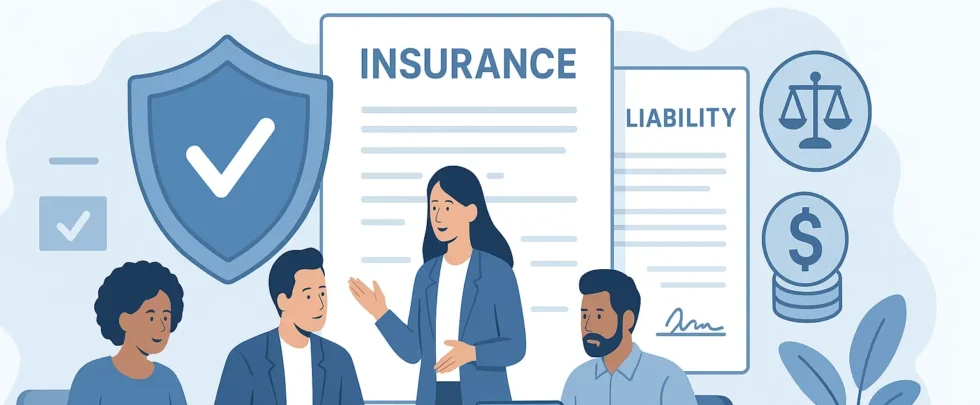Nonprofit Liability Insurance: Simple Guide to Costs & Coverage

A nonprofit comes with a mission and risks. Your organization juggles legal and financial risks on a daily basis, from hosting community events to retaining volunteers and holding fundraisers. Liability insurance for nonprofits is intended to keep the people, finances and reputation of your organization safe.
In this guide, we’ll explore:
- What nonprofit liability insurance is
- Types of coverage available
- Average Nonprofit Liability Insurance Cost
- Factors that influence pricing
- Deciding on the right policy.
What Is Nonprofit Liability Insurance?
Nonprofit liability insurance is a form of insurance that protects nonprofit organizations from lawsuits, property damage claims, and other financial liabilities. Nonprofits with the best intentions in mind can be sued by employees, volunteers, vendors, donors or even members of the public.
And if you are not properly insured, these legal matters can cost your organization so much money that it may not survive.
Why Nonprofits Need Liability Insurance
Some of the worst-case scenarios in which you need liability insurance are:
- An injury to a volunteer working on events.
- Participant Alleges Food Poisoning After Fundraising Dinner
- An employee files a claim for violations like wrongful termination or discrimination.
- A donor complains that the nonprofit is stealing money.
In both cases, insurance will help bear the costs of legal defense, settlements and other related expenses that your organization would rather not spend time and resources fighting.
Types of Nonprofit Liability Insurance Coverage
1. General Liability Insurance
This provides coverage for claims by third parties such as bodily injury, property damage and personal injury. It is usually the only policy that most non-profits purchase.
EXAMPLE: In case a visitor trips on an extension cord at your office, general liability insurance packages can address medical bills and legal fees.
2. Directors and Officers (D&O) Insurance
Insulates and protects board members and executives in case the nonprofit is sued for actions they took on its behalf.
For instance, if board members are sued by donors for misuse of funds — D&O insurance can cover legal defense.
3. Professional Liability (Errors & Omissions) Insurances
Protects against complaints about your services being subpar or negligent comedienne post.
For Example: A client says that your program did not actually provide the results you promised.
4. Employment Practices Liability Insurance (EPLI)
Employment Practices: Covers employment-related claims such as discrimination, harassment and wrongful termination.
5. Cyber Liability Insurance
Data breaches as well as cyber-attacks are a growing concern for non-profits and the individual donor data entrusted to them.
6.Event Liability Insurance
Offers event-specific coverages such as fundraisers or gala coverage for a limited time.
Nonprofit Liability Insurance Cost
Average Cost
Here are the average annual premiums for small to mid-sized nonprofits in the U.S., but prices vary:
- General Liability: $400 – $600
- D&O Insurance: $500 – $1,200
- EPLI: $800 – $2,000
- Cyber Liability: $500 – $1,500
Factors Affecting Cost
- Organization Size – Larger organizations with more staff or volunteers tend to have higher premiums.
- Activities – What you are doing (riskier activities such as throwing a big event or working internationally will cost more than cooking for some friends).
- Claims History. If you have a history of lawsuits or insurance claims expect to pay more.
- Limits — The higher your limits, the more protection you get…as well as the expense.
- Location: State laws, local risk factors and a higher cost of living can all contribute to higher or lower insurance costs.
Choosing the Best Policy for You
- Identify Your Risks – Define risks based on type of business and number of your activity.
- Talk to an Insurance Broker – Find out from them the risks that nonprofits are most exposed to.
- Getting Multiple Quotes – Prices and coverage between insurers can vary significantly.
- Annually — Things may change as your organization grows so it’s important to do an annual insurance review.
- Bundle Policies — As a bundler, you can save on the cost of any insurance since you get savings in multi-policies discounts.
Tips for Reducing Liability Risks
- Conduct ongoing safety training; for both your employees and volunteers.
- Define clear procedures to deal with complaints and disagreements.
- Record meetings, finances, and decisions in detail.
- Safety precautions for all events
- Use a standard of comfort technology for safekeeping the donor or client data.
Conclusion
Turning now to nonprofit liability insurance, think of it as being just like that safety net. With a solid grasp of the various types of coverage, understanding of the average cost for nonprofit liability insurance, and informed selection from these policies, your organization will be able to avoid financial and legal threats while keeping its eyes locked on its primary mission.
